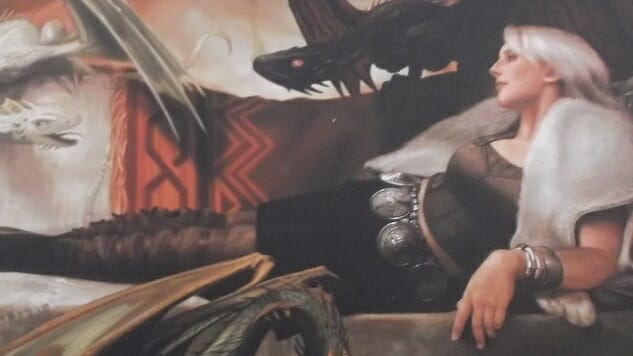A Game of Thrones: The Card Game Second Edition

I should state up front that I am in no way a fan of A Game of Thrones; I despised the first book (among other things, I found it rapey) and haven’t watched the popular HBO series. So I suppose that the fact that I enjoyed the second edition of a deckbuilder game based in that universe, simply titled A Game of Thrones: The Card Game, should give you some indication of how clever the game is, bringing surprising strategic complexity to a relatively straightforward offering.
AGoT: The Card Game is a “Living Card Game,” Fantasy Flight Games’ term for deckbuilders that will be enhanced and supplemented by future deck releases, but the base game has enough cards for two to four players to play repeatedly without becoming monotonous due to the depth and size of the decks. Players can build their own decks from what’s in the box, or can choose any of the four recommended starter decks; those latter decks are big enough that I haven’t felt any need or desire to build my own because I’m still learning everything that’s available to me in the starter packs.
Each player takes on the role of a specific House, the names of which will be familiar to fans of the series—Stark, Greyjoy, the Night Watch, Targaryen, etc.—and plays a deck that includes characters and locations specific to that house and, typically, one other house as well, so each player begins the game with 45 cards (using the pre-set decks), as well as seven plot cards that set players’ rights, income and strategy for each round. During a round, players will “marshal” (pay for and place) cards from their hands to the table, then use them in challenges against other players, either attacking or defending, to try to gain points or damage their opponents.
Game play centers on those two elements—plot cards and challenges. Each plot card has four numbers on it as well as one or two categories, and those, not to exaggerate, determine everything that follows. The numbers represent that player’s income for that turn, his/her “initiative” (determining player order for that round), his/her “claim” (how much damage or benefit a successful challenge entails, such as power points gained from a defeated opponent), and the number of cards that player can retain in his/her hand at round’s end. The category or categories introduce interactions with other cards that the players may invoke during the round, some of which only work under certain plot types or gain a new power in those situations. Most plot cards also have a line or two of text that affects game play just for that round, such as reducing an opponent’s income to zero if s/he has a specific plot category in play or limiting any player challenge to just one card per side. You choose your plot card for each round, cycling through all seven before you can reuse any, so balancing your desired income with your wish to go first or to use a plot card’s special abilities represents one major strategic decision that will come up repeatedly over the course of one game.
After all players have played plot cards, collected income, and drawn two cards from their decks to their hands, the marshaling phase begins, where players deploy character, location, or attachment cards to their play areas, paying the cost in gold shown in the upper left corner of the cards. There are various discounts available through other cards—say, activate this card to reduce the cost of any House Stark card by one, or sacrifice this card from your play area to play any card for free—and gold can’t be saved for future rounds, so smart marshaling is critical (although I suppose that’s obvious for any deckbuilder).
-

-

-

-

-

-

-

-

-

-

-

-

-

-

-

-

-

-

-

-

-

-

-

-

-

-

-

-

-

-

-

-

-

-

-

-

-

-

-

-









































